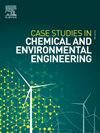Electricity generation from co-pyrolysis gas of fresh palm fruit bunches and medical waste plastic bottles for sustainable energy applications
Q1 Environmental Science
Case Studies in Chemical and Environmental Engineering
Pub Date : 2025-05-21
DOI:10.1016/j.cscee.2025.101240
引用次数: 0
Abstract
Co-pyrolysis gas produced from the co-pyrolysis of fresh palm fruit bunches and medical waste plastic bottles using a batch pyrolyzer integrated with a downdraft gasifier was evaluated for sustainable electricity generation. Increasing the plastic fraction enhanced the gas heating value (41.43–55.53 MJ/Nm3) but decreased gas yield from 22.7 % to 9.0 %. Electrical efficiency was calculated based on the ratio of output power to syngas energy content, achieving 8.96–9.01 %. Engine tests showed a reduction in CO emissions (30,149–17,419 ppm) and comparable NOx levels to gasoline combustion. These results demonstrate the co-pyrolysis gas's potential as a renewable fuel for decentralized power.
利用新鲜棕榈果串和医疗废弃塑料瓶共热解气体发电,实现可持续能源应用
利用与下吸式气化炉集成的间歇式热解装置,对新鲜棕榈果束和医疗废弃塑料瓶共热解产生的共热解气体进行了可持续发电评估。增加塑料掺量可提高燃气热值(41.43 ~ 55.53 MJ/Nm3),但气产率从22.7%降至9.0%。根据输出功率与合成气能量含量之比计算电效率,达到8.96 ~ 9.01%。发动机测试表明,CO排放量(30,149-17,419 ppm)和NOx水平与汽油燃烧相当。这些结果证明了共热解气作为分散式电力的可再生燃料的潜力。
本文章由计算机程序翻译,如有差异,请以英文原文为准。
求助全文
约1分钟内获得全文
求助全文
来源期刊

Case Studies in Chemical and Environmental Engineering
Engineering-Engineering (miscellaneous)
CiteScore
9.20
自引率
0.00%
发文量
103
审稿时长
40 days
 求助内容:
求助内容: 应助结果提醒方式:
应助结果提醒方式:


